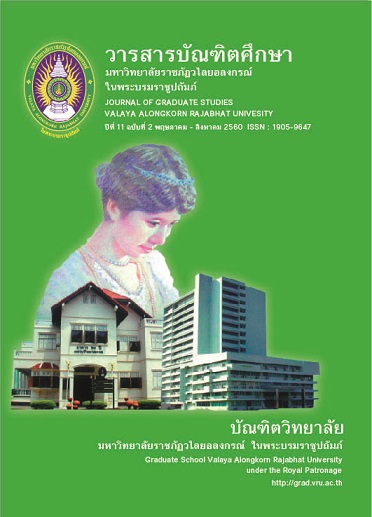การศึกษารูปแบบการจัดการท่องเที่ยวอย่างยั่งยืนที่ส่งผลต่อการพัฒนามาตรฐานคุณภาพแหล่งท่องเที่ยวทางวัฒนธรรมของจังหวัดในเขตภาคกลาง
Main Article Content
Abstract
บทคัดย่อ
งานวิจัยนี้มุ่งศึกษาระดับการจัดการท่องเที่ยวอย่างยั่งยืน ระดับมาตรฐานคุณภาพแหล่งท่องเที่ยวทางวัฒนธรรม และรูปแบบการจัดการท่องเที่ยวอย่างยั่งยืนที่ส่งผลต่อการพัฒนามาตรฐานคุณภาพแหล่งท่องเที่ยวทางวัฒนธรรมของจังหวัดในเขตภาคกลาง โดยวิเคราะห์ข้อมูลด้วยโมเดลสมการโครงสร้าง ตัวแปรเกณฑ์ คือ หลักการจัดการท่องเที่ยวอย่างยั่งยืน ตัวแปรพยากรณ์ คือ มาตรฐานคุณภาพแหล่งท่องเที่ยวทางวัฒนธรรม ประชากร แบ่งเป็น 2 กลุ่ม คือ นักท่องเที่ยวที่ในแหล่งท่องเที่ยวทางธรรมชาติของจังหวัดในเขตภาคกลาง ในปี 2556 จำนวน 18,175,708 คน และประชาชนในแหล่งท่องเที่ยวทางวัฒนธรรมในจังหวัดนั้นไม่ทราบจำนวน กำหนดกลุ่มตัวอย่างโดยใช้โปรแกรม G*Power3.1 ได้กลุ่มตัวอย่าง กลุ่มละ 500 คน การสุ่มตัวอย่างแบบหลายขั้นตอน เครื่องมือที่ใช้ในการวิจัย ได้แก่ ระดับการนำหลักการจัดการท่องเที่ยวอย่างยั่งยืนมาปฏิบัติ ระดับมาตรฐานคุณภาพแหล่งท่องเที่ยวทางวัฒนธรรม สถิติที่ใช้ในการวิจัย ได้แก่ ค่าเฉลี่ยและส่วนเบี่ยงเบนมาตรฐาน การวิเคราะห์องค์ประกอบเชิงยืนยัน การวิเคราะห์โมเดลสมการโครงสร้าง
ผลการวิจัยพบว่า ประชาชนในแหล่งท่องเที่ยวมีการนำหลักการจัดการท่องเที่ยวอย่างยั่งยืนมาปฏิบัติ อยู่ในระดับมาก โดยมีการอนุรักษ์และการใช้ทรัพยากรอย่างพอดีสูงสุด มีระดับมาตรฐานคุณภาพแหล่งท่องเที่ยวทางวัฒนธรรม อยู่ในระดับดีมาก โดยมีศักยภาพในการรองรับด้านการท่องเที่ยวสูงสุด ผลการทดสอบสมมติฐานพบว่า หลักการจัดการท่องเที่ยวอย่างยั่งยืน มีอิทธิพลต่อมาตรฐานคุณภาพแหล่งท่องเที่ยวทางวัฒนธรรมของจังหวัดในเขตภาคกลาง ร้อยละ 41
โดยรูปแบบการจัดการท่องเที่ยวอย่างยั่งยืน 5 อันดับแรกที่ส่งผลต่อมาตรฐานคุณภาพแหล่งท่องเที่ยวทางวัฒนธรรมของจังหวัดในเขตภาคกลาง ได้แก่ การประสานการพัฒนาการท่องเที่ยวสูงสุด การมีส่วนร่วมโดยการสร้างเครือข่ายพัฒนาการท่องเที่ยวกับท้องถิ่น การฝึกอบรมบุคลากรในท้องถิ่น การรักษาและส่งเสริมความหลากหลายของทรัพยากรธรรมชาติ และการจัดเตรียมข้อมูลคู่มือบริการข่าวสารการท่องเที่ยวให้พร้อม
ABSTRACT
This research aims to study the sustainable tourism management level, the cultural attractions’ level of standards, and the sustainable tourism models that effects of the cultural attractions’ quality standards in central provinces by the structural equation modeling analysis. The criterion variable is the principles of sustainable tourism management and the cultural attractions’ quality standards acts as the predictor variable. The population used in this study was divided into two groups: one was 18,175,708 tourists in central provinces’ natural attractions in 2013, the other was the unknown number of the local residing at the cultural attraction in each province. Calculated by G*Power 3.1, the sample size for each group was 500 respondents who were selected by multi-stage sampling technique. The mean and standard deviation were employed in the statistical analysis of the data. The confirmatory factor analysis and the structural equation modeling analysis were also included in the study.
The results showed that the local, residing at the cultural attractions, scored high in adapting the principles of sustainable tourism into practice with the proper use and conservation of resource performed as the highest principle. The quality standards of cultural attractions were ranked excellent, with the highest level in tourism carrying capacity. The hypothesis testing revealed that the principles of sustainable tourism affected the cultural attractions in the central provinces at 41%. The Model of Sustainable Tourism Management should focus on the top five principles of sustainable tourism management including integrating tourism into planning, involving local communities, training staff, maintaining diversity and marketing tourism responsibly.
Article Details

This work is licensed under a Creative Commons Attribution-NonCommercial-NoDerivatives 4.0 International License.
บทความทุกเรื่องได้รับการตรวจความถูกต้องทางวิชาการโดยผู้ทรงคุณวุฒิ ทรรศนะและข้อคิดเห็นในบทความ Journal of Global of Perspectives in Humanities and Social Sciences (J-GPHSS) มิใช่เป็นทรรศนะและความคิดของผู้จัดทำจึงมิใช่ความรับผิดชอบของบัณฑิตวิทยาลัย มหาวิทยาลัยราชภัฏวไลยอลงกรณ์ ในพระบรมราชูปถัมภ์ กองบรรณาธิการไม่สงวนสิทธิ์การคัดลอก แต่ให้อ้างอิงแหล่งที่มา


